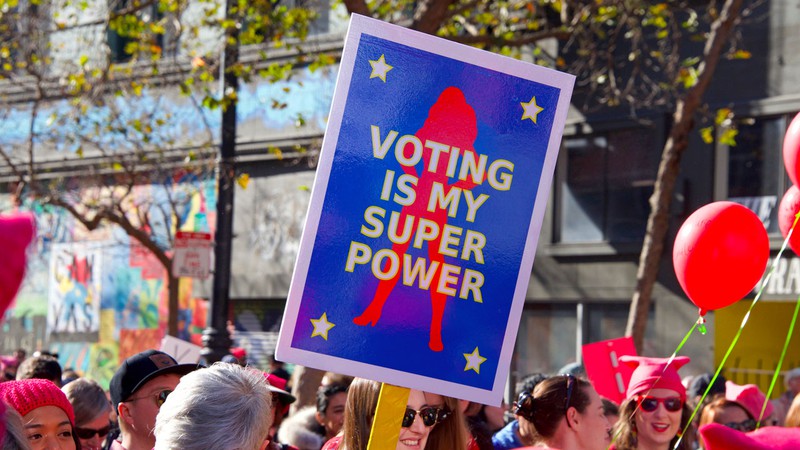
The streets of San Francisco saw one of the many women's marches held after the 2016 election. Sheila Fitzgerald Shutterstock
During election season, when campaign fliers clog our mailboxes and television ads rail about the shortcomings of candidates or the shortsightedness of propositions, it’s hard to find neutral, fact-based information about the choices we’ll be making on our ballots. One organization has spent more than a century supplying just that.
The League of Women Voters has been active ever since the women’s suffrage movement ended in victory and the 19th Amendment was ratified on Aug. 18, 1920. The League was created as the successor to the National American Woman Suffrage Association, moving the focus from obtaining the vote to helping women exercise their newly won right.
Nowadays, the goal is to protect everyone’s right to vote, regardless of gender, race, party affiliation or ability. Throughout the decades, the LWV has celebrated hundreds of voting rights victories.
This nonprofit, nonpartisan organization provides information on ballot measures and races without supporting or opposing specific candidates or political parties. There are active leagues in all 50 states, totaling more than 750 chapters and more than 500,000 members.
In some counties, there is one central chapter, such as in Santa Cruz County and Nevada County. In Santa Clara County—the most populous county in Northern California—five different chapters are active, following races from the San Francisco Peninsula to the rural South County.
Current LWV Priorities
As the decades have passed and political climates changed, so has the LWV’s work. The following are focal points at present.
Expanding Voter Access: LWV is continually fighting to make it easier for citizens to access and submit their ballots. This includes early voting expansion, online voter registration, automatic registrations, and extended polling hours. Expanding voter resources in multiple languages is another priority. LWV recognizes that single parents, low-income families, and those not proficient in English can face barriers to voting, and the League aims to aid these voters.
Fighting Voter Suppression: It’s shocking but true that more than 50 years after the Voting Rights Act was passed, voter suppression is still a serious issue. The most widely used forms include proof-of-citizenship restrictions and not accepting voter IDs, restricting polling place hours in communities of color, and eliminating early voting or mail-in ballots. LWV is continually working for combat these measures of discouraging democratic participation.
Monitoring the Redistricting Process: Every 10 years following the U.S. Census, the redistricting process begins. The goal is to ensure political districts remain fair and accurately represented. Unfortunately, politicians have been known to manipulate the process in order to preserve their own power—or even expand it. When this comes at the expense of a political party or a marginalized demographic, it is called gerrymandering. LWV fights to make the process transparent and fair.
Fighting the Influence of Money in Politics: Campaigning for a public office is expensive, and politicians are under constant pressure to raise money—which can leave them beholden to special interests with deep pockets. LWV is working to develop an “equitable small-dollar funding system” for elections, so that every voter counts no matter how much they contribute financially to a candidate.
Candidate Information, Live and Online
One of the time-honored ways in which the League of Women Voters provides information to the electorate is by sponsoring candidate forums in local races. In Santa Clara County, for instance, the LWV of San Jose and Santa Clara held events that spotlighted candidates for county sheriff, the District 1 supervisorial seat, and the San Jose mayoral and City Council races—all of which can be found on LVW SJSC’s YouTube page.
Another tool for augmenting the information provided by the state’s county election departments is the VotersEdge.org website, which collects information on candidates and measures in all of California’s 58 counties.
VotersEdge.org is an offshoot of SmartVoter.org, which the LWV describes as one of the nation’s first election information websites. It has been providing nonpartisan coverage of election contests, candidates and ballot measures since 1996. In 2014, the LWV joined forces with MapLight—a nonpartisan, nonprofit research organization that studies money’s influence on politics—to create Voters Edge, which provides top-to-bottom ballot and campaign finance information in one easy-to-use site.
League of Extraordinary Gentlewomen…and Men
Since 1973, LWV membership has been open to men as well as women. Local chapters serve as grassroots organizations, giving members an opportunity to serve the local community, discover new skills and interests, and develop lifelong personal and professional connectionss.
Members can choose to volunteer as little or as much as they choose. Some only pay annual dues; others attend meetings, participate in projects, or take on leadership roles. Membership is an important way to provide support: There is power in numbers when it comes to political movements.
When members join a local chapter, they also can participate with LWV on multiple levels: as part of the League of Women Voters of California, and the League of Women Voters of the United States. Members receive newsletters and other literature to keep them informed and to encourage them to get involved with voting rights across the nation.
For more information about The League of Women Voters, visit the national website or find your local chapter.
Long form articles which explain how something works, or provide context or background information about a current issue or topic.